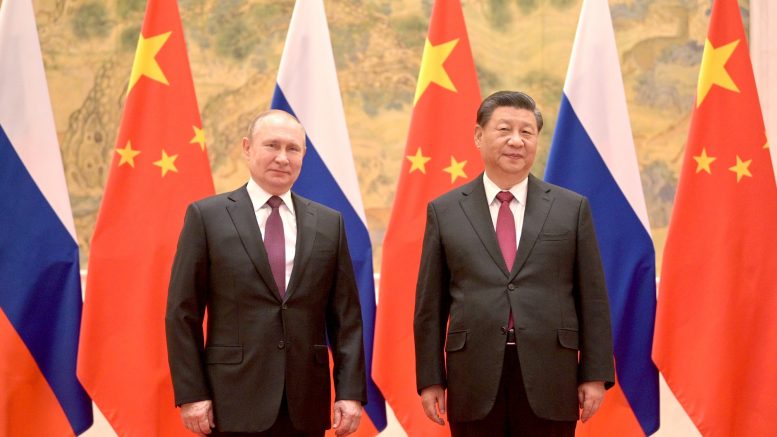The Northern Miner has put together a list of five trends we believe encapsulate the drama of 2022.
1 Geopolitical ‘curveballs’
Russia’s invasion of Ukraine was certainly the biggest geopolitical shock of 2022 — and one that continues to disrupt commodities markets and feed an energy crisis in Europe. While miners have benefitted from higher prices, it’s come at the cost of great uncertainty and volatility.
Even so, the war wasn’t the only big shock of 2022. By one analyst’s count, there were at least six major events that made last year a rocky one, throwing “a geopolitical curveball” to investors every two months.
In a Jan. 6 note, Zoltan Pozsar, the global head of short-term interest rate strategy at Credit Suisse said the events all represent “fronts” in a global struggle for power as the world fragments into a multipolar order. They ranged from the G7’s “financial blockade” of Russia to China’s naval blockade of Taiwan and its challenge to the petrodollar by pushing for yuan-priced oil contracts. Underlining how different this environment really is from the previous status quo, Pozsar notes that investors haven’t had to consider geopolitical risk for generations because of the “cocoon” of a “unipolar world order, under the cover of Pax Americana.”
No wonder UBS analysts called 2022 “one of the most challenging years in history for investors,” in its 2023 outlook.
The geopolitical tensions are giving rise to resource nationalism and as UBS analysts wrote in their “Year Ahead 2023” note, a strong emphasis on security.
“We believe we are at the beginning of an era of security, in which energy security, food security, and technological security will be increasingly prioritized by governments and businesses, even if they come at the cost of efficiency,” they wrote.
The ‘silver’ lining?
“We expect the era of security to drive commodity prices higher over the long term. A focus on sourcing supplies from allied nations, structural underinvestment, efforts to achieve net-zero emissions, and a need to meet growing emerging market demand should all help support prices.”
2 Cost crunch
Miners saw intense cost inflation in 2022, both in operating costs and in capital costs at new developments and mine expansions.
Probably the most dramatic increase has been at the Côté gold joint venture in Ontario, where Iamgold revealed in August that the total price tag had reached US$3 billion, up from around US$1.3 billion in 2020. Argonaut Gold’s Magino, Teck Resources’ QB2 in Chile, and Rio Tinto’s Oyu Tolgoi expansion in Mongolia, and others have also experienced rising capital costs.
On the operations side, gold miners saw average all-in sustaining costs (AISC) climb to an all-time high of US$1,289 per oz. in the third quarter of 2022, according to the World Gold Council. That’s up 14% from the third quarter of 2021, and 32% higher than the same quarter two years ago, thanks to rising labour and input costs — including fuel, wrote Adam Webb, WGC’s director of mine supply, metals focus, in a mid-December post. In the third quarter, more than 9% of gold was produced at an AISC that was greater than the gold price.
Although costs may remain high this year, they only rose 1% in the most recent quarter, indicating a cool down in the trend. Prices are not expected to see the same steep rises this year, and could see a “modest contraction” in the second half, assuming a pullback of oil and gas prices, Webb wrote.
3 CEO turnover
In such a difficult environment, it’s no surprise that some CEOs lost their jobs last year. Agnico Eagle Mines, Gold Fields, Newcrest Mining, Iamgold, and Centerra Gold were just some of the companies that saw a change in leadership.
In some cases the changeout was due to underperformance, in others it was a reported culture clash (Agnico’s CEO Tony Makuch, who resigned less than two weeks after taking on the CEO role in early 2022) and in Gold Fields’ case, the failure of its planned merger with Yamana Gold.
4 Onshoring/reshoring
Not all of 2022’s trends were negative. With the Canadian and U.S. governments both getting serious about critical minerals policy and security last year, it was hard to keep up with the announcements for new investments by global companies in electric vehicle plants, EV battery manufacturing, and in critical minerals projects and companies — about two dozen in all amounting to more than $11 billion. The announcements also strengthened cooperation between Canadian and American, Japanese, Korean and German governments and industry, while the U.S. Inflation Reduction Act was a boon for investment, making EVs produced in Canada and with Canadian minerals eligible for U.S. EV incentives.
5 Selective M&A
The hunt for quality assets in a subdued market drove M&A in gold, copper, lithium — and even uranium in 2022.
Big deals included Agnico Eagle Mines and Pan American Silver’s US$4.8-billion bid for Yamana Gold (following Agnico’s US$10-billion takeover of Kirkland Lake Gold, which closed in early 2022) and Rio Tinto’s US$3.3-billion takeover of Turquoise Hill Resources.
While the dollar amounts were lower, there was notable consolidation in the royalty sector, which offers coveted protection from cost pressures, execution risk and diversification of geopolitical risk. Deals included Sandstorm Gold’s $646.4-million acquisition of Nomad Royalty; Triple Flag Precious Metals’ $606-million purchase of Maverix Metals, an all-share merger of Elemental Resources and Altus Strategies; and Royal Gold’s buyout of Great Bear Royalties for $200 million.





Be the first to comment on "Five trends that defined 2022"